ABS FIAT 500L 2018 Owner handbook (in English)
[x] Cancel search | Manufacturer: FIAT, Model Year: 2018, Model line: 500L, Model: FIAT 500L 2018Pages: 268, PDF Size: 4.87 MB
Page 6 of 268
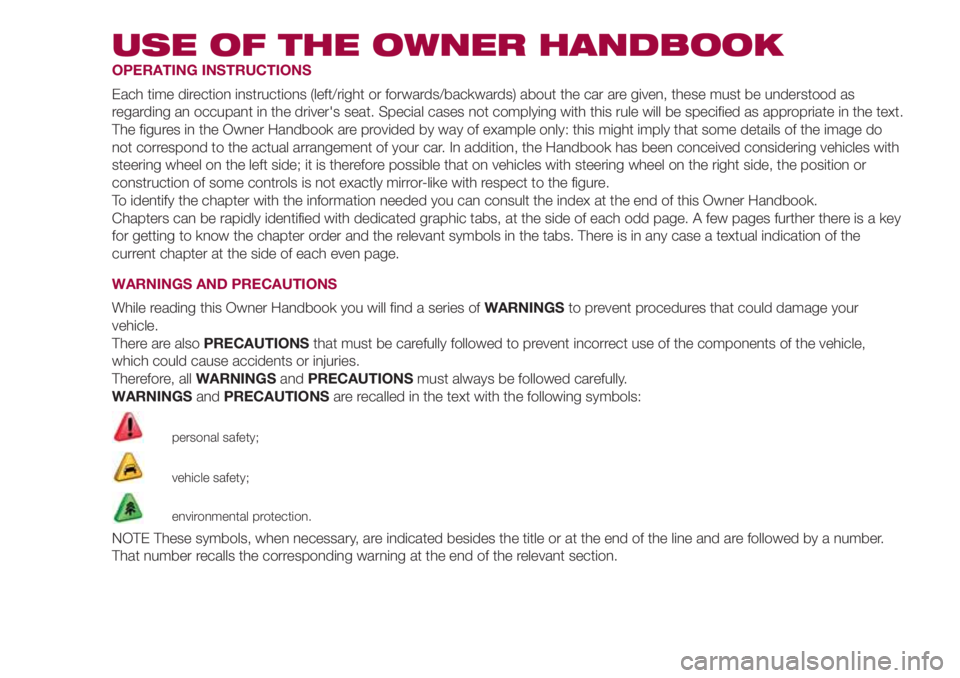
USE OF THE OWNER HANDBOOK
OPERATING INSTRUCTIONS
Each time direction instructions (left/right or forwards/backwards) about the car are given, these must be understood as
regarding an occupant in the driver's seat. Special cases not complying with this rule will be specified as appropriate in the text.
The figures in the Owner Handbook are provided by way of example only: this might imply that some details of the image do
not correspond to the actual arrangement of your car. In addition, the Handbook has been conceived considering vehicles with
steering wheel on the left side; it is therefore possible that on vehicles with steering wheel on the right side, the position or
construction of some controls is not exactly mirror-like with respect to the figure.
To identify the chapter with the information needed you can consult the index at the end of this Owner Handbook.
Chapters can be rapidly identified with dedicated graphic tabs, at the side of each odd page. A few pages further there is a key
for getting to know the chapter order and the relevant symbols in the tabs. There is in any case a textual indication of the
current chapter at the side of each even page.
WARNINGS AND PRECAUTIONS
While reading this Owner Handbook you will find a series ofWARNINGSto prevent procedures that could damage your
vehicle.
There are alsoPRECAUTIONSthat must be carefully followed to prevent incorrect use of the components of the vehicle,
which could cause accidents or injuries.
Therefore, allWARNINGSandPRECAUTIONSmust always be followed carefully.
WARNINGSandPRECAUTIONSare recalled in the text with the following symbols:
personal safety;
vehicle safety;
environmental protection.
NOTE These symbols, when necessary, are indicated besides the title or at the end of the line and are followed by a number.
That number recalls the corresponding warning at the end of the relevant section.
Page 16 of 268
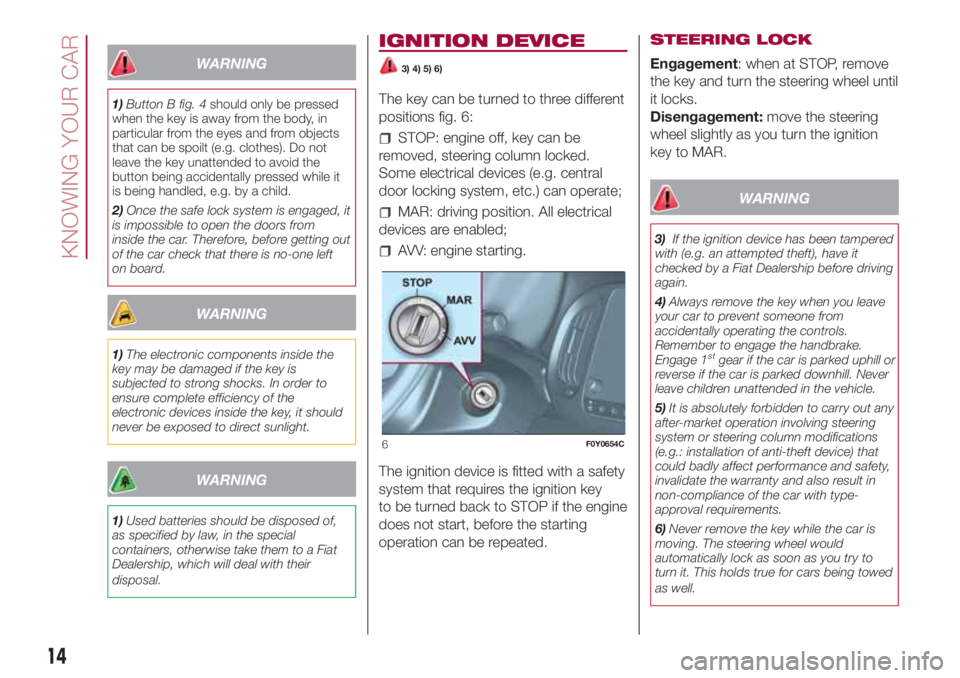
WARNING
1)Button B fig. 4should only be pressed
when the key is away from the body, in
particular from the eyes and from objects
that can be spoilt (e.g. clothes). Do not
leave the key unattended to avoid the
button being accidentally pressed while it
is being handled, e.g. by a child.
2)Once the safe lock system is engaged, it
is impossible to open the doors from
inside the car. Therefore, before getting out
of the car check that there is no-one left
on board.
WARNING
1)The electronic components inside the
key may be damaged if the key is
subjected to strong shocks. In order to
ensure complete efficiency of the
electronic devices inside the key, it should
never be exposed to direct sunlight.
WARNING
1)Used batteries should be disposed of,
as specified by law, in the special
containers, otherwise take them to a Fiat
Dealership, which will deal with their
disposal.
IGNITION DEVICE
3) 4) 5) 6)
The key can be turned to three different
positions fig. 6:
STOP: engine off, key can be
removed, steering column locked.
Some electrical devices (e.g. central
door locking system, etc.) can operate;
MAR: driving position. All electrical
devices are enabled;
AVV: engine starting.
The ignition device is fitted with a safety
system that requires the ignition key
to be turned back to STOP if the engine
does not start, before the starting
operation can be repeated.STEERING LOCK
Engagement: when at STOP, remove
the key and turn the steering wheel until
it locks.
Disengagement:move the steering
wheel slightly as you turn the ignition
key to MAR.
WARNING
3)If the ignition device has been tampered
with (e.g. an attempted theft), have it
checked by a Fiat Dealership before driving
again.
4)Always remove the key when you leave
your car to prevent someone from
accidentally operating the controls.
Remember to engage the handbrake.
Engage 1
stgear if the car is parked uphill or
reverse if the car is parked downhill. Never
leave children unattended in the vehicle.
5)It is absolutely forbidden to carry out any
after-market operation involving steering
system or steering column modifications
(e.g.: installation of anti-theft device) that
could badly affect performance and safety,
invalidate the warranty and also result in
non-compliance of the car with type-
approval requirements.
6)Never remove the key while the car is
moving. The steering wheel would
automatically lock as soon as you try to
turn it. This holds true for cars being towed
as well.
6F0Y0654C
14
KNOWING YOUR CAR
Page 21 of 268
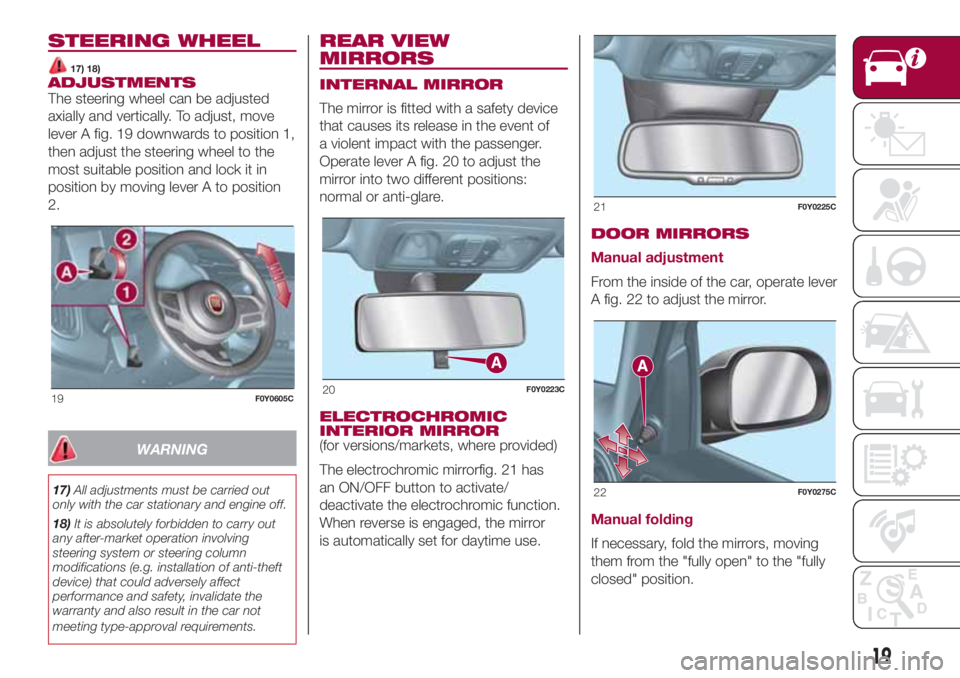
STEERING WHEEL
17) 18)ADJUSTMENTS
The steering wheel can be adjusted
axially and vertically. To adjust, move
lever A fig. 19 downwards to position 1,
then adjust the steering wheel to the
most suitable position and lock it in
position by moving lever A to position
2.
WARNING
17)All adjustments must be carried out
only with the car stationary and engine off.
18)It is absolutely forbidden to carry out
any after-market operation involving
steering system or steering column
modifications (e.g. installation of anti-theft
device) that could adversely affect
performance and safety, invalidate the
warranty and also result in the car not
meeting type-approval requirements.
REAR VIEW
MIRRORS
INTERNAL MIRROR
The mirror is fitted with a safety device
that causes its release in the event of
a violent impact with the passenger.
Operate lever A fig. 20 to adjust the
mirror into two different positions:
normal or anti-glare.
ELECTROCHROMIC
INTERIOR MIRROR
(for versions/markets, where provided)
The electrochromic mirrorfig. 21 has
an ON/OFF button to activate/
deactivate the electrochromic function.
When reverse is engaged, the mirror
is automatically set for daytime use.DOOR MIRRORS
Manual adjustment
From the inside of the car, operate lever
A fig. 22 to adjust the mirror.
Manual folding
If necessary, fold the mirrors, moving
them from the "fully open" to the "fully
closed" position.
19F0Y0605C20F0Y0223C
21F0Y0225C
22F0Y0275C
19
Page 37 of 268
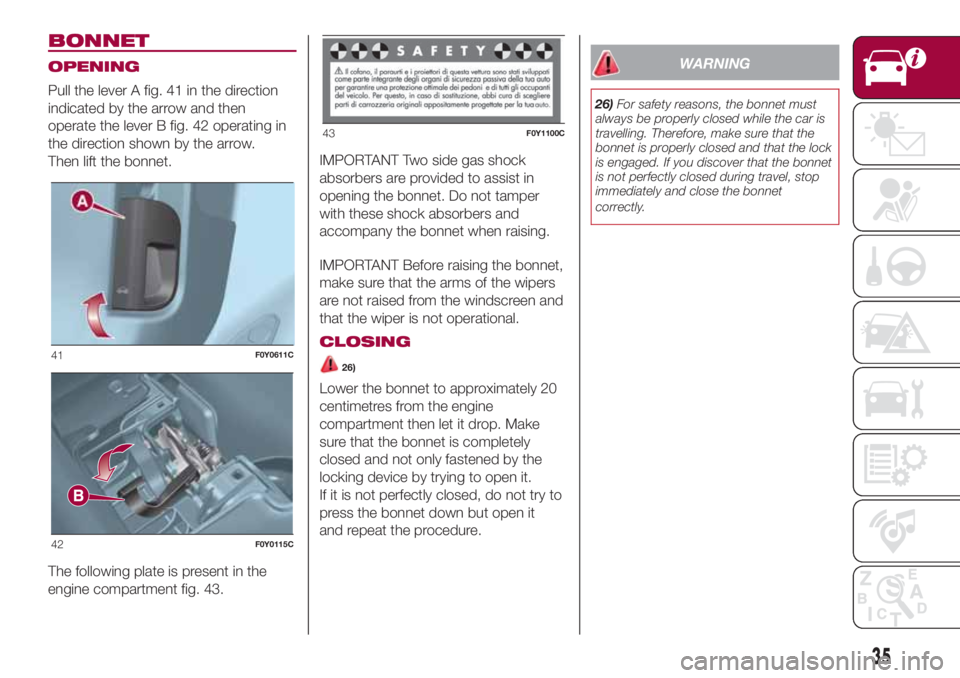
BONNET
OPENING
Pull the lever A fig. 41 in the direction
indicated by the arrow and then
operate the lever B fig. 42 operating in
the direction shown by the arrow.
Then lift the bonnet.
The following plate is present in the
engine compartment fig. 43.IMPORTANT Two side gas shock
absorbers are provided to assist in
opening the bonnet. Do not tamper
with these shock absorbers and
accompany the bonnet when raising.
IMPORTANT Before raising the bonnet,
make sure that the arms of the wipers
are not raised from the windscreen and
that the wiper is not operational.
CLOSING
26)
Lower the bonnet to approximately 20
centimetres from the engine
compartment then let it drop. Make
sure that the bonnet is completely
closed and not only fastened by the
locking device by trying to open it.
If it is not perfectly closed, do not try to
press the bonnet down but open it
and repeat the procedure.
WARNING
26)For safety reasons, the bonnet must
always be properly closed while the car is
travelling. Therefore, make sure that the
bonnet is properly closed and that the lock
is engaged. If you discover that the bonnet
is not perfectly closed during travel, stop
immediately and close the bonnet
correctly.
41F0Y0611C
42F0Y0115C
43F0Y1100C
35
Page 41 of 268
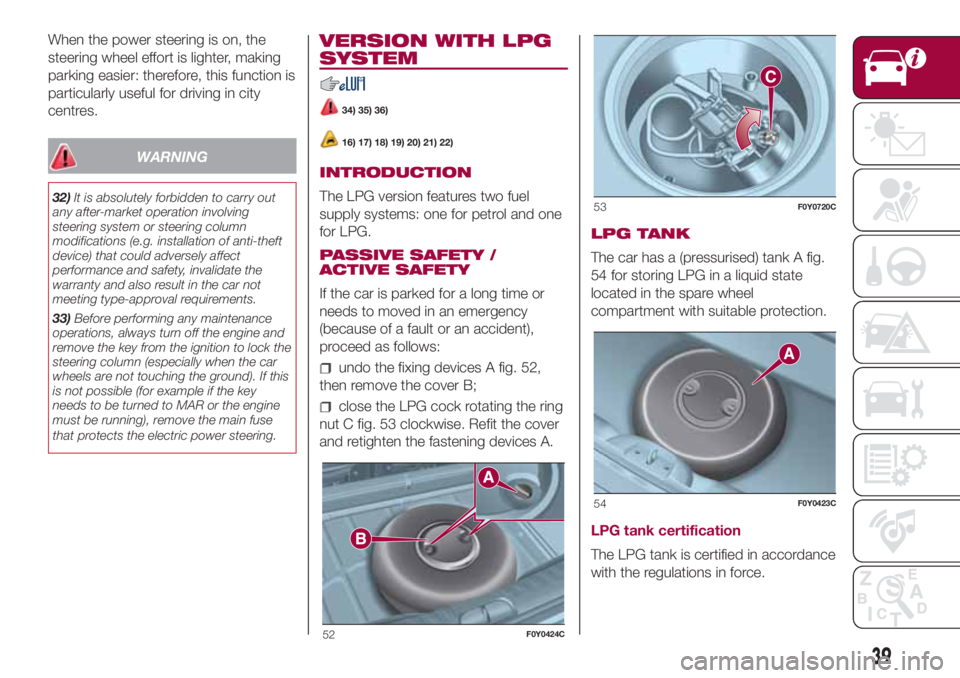
When the power steering is on, the
steering wheel effort is lighter, making
parking easier: therefore, this function is
particularly useful for driving in city
centres.
WARNING
32)It is absolutely forbidden to carry out
any after-market operation involving
steering system or steering column
modifications (e.g. installation of anti-theft
device) that could adversely affect
performance and safety, invalidate the
warranty and also result in the car not
meeting type-approval requirements.
33)Before performing any maintenance
operations, always turn off the engine and
remove the key from the ignition to lock the
steering column (especially when the car
wheels are not touching the ground). If this
is not possible (for example if the key
needs to be turned to MAR or the engine
must be running), remove the main fuse
that protects the electric power steering.
VERSION WITH LPG
SYSTEM
34) 35) 36)
16) 17) 18) 19) 20) 21) 22)
INTRODUCTION
The LPG version features two fuel
supply systems: one for petrol and one
for LPG.
PASSIVE SAFETY /
ACTIVE SAFETY
If the car is parked for a long time or
needs to moved in an emergency
(because of a fault or an accident),
proceed as follows:
undo the fixing devices A fig. 52,
then remove the cover B;
close the LPG cock rotating the ring
nut C fig. 53 clockwise. Refit the cover
and retighten the fastening devices A.LPG TANK
The car has a (pressurised) tank A fig.
54 for storing LPG in a liquid state
located in the spare wheel
compartment with suitable protection.
LPG tank certification
The LPG tank is certified in accordance
with the regulations in force.
52F0Y0424C
53F0Y0720C
54F0Y0423C
39
Page 42 of 268
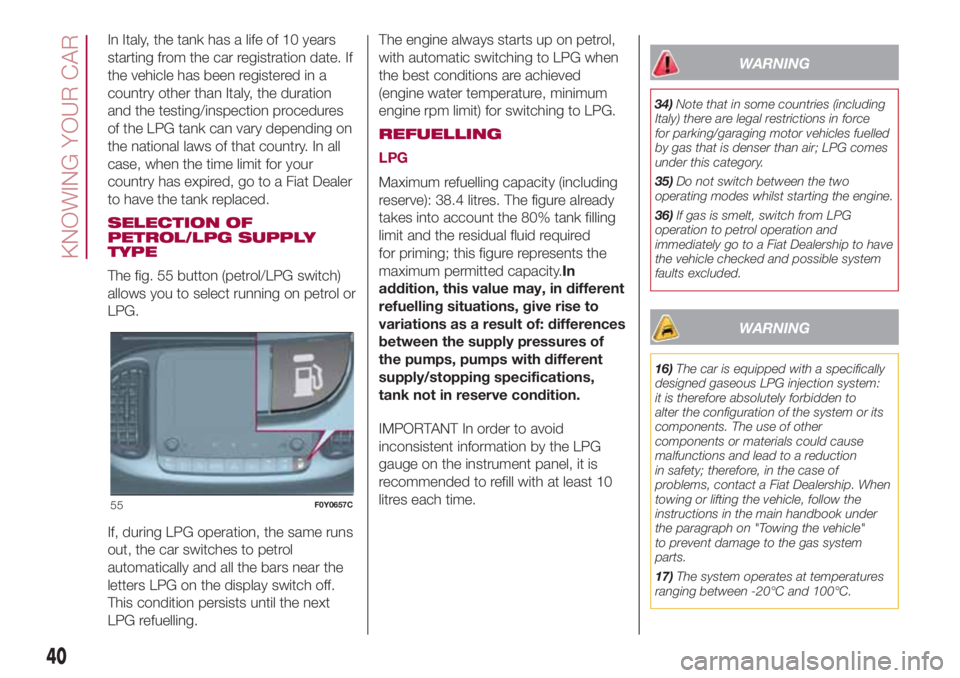
In Italy, the tank has a life of 10 years
starting from the car registration date. If
the vehicle has been registered in a
country other than Italy, the duration
and the testing/inspection procedures
of the LPG tank can vary depending on
the national laws of that country. In all
case, when the time limit for your
country has expired, go to a Fiat Dealer
to have the tank replaced.
SELECTION OF
PETROL/LPG SUPPLY
TYPE
The fig. 55 button (petrol/LPG switch)
allows you to select running on petrol or
LPG.
If, during LPG operation, the same runs
out, the car switches to petrol
automatically and all the bars near the
letters LPG on the display switch off.
This condition persists until the next
LPG refuelling.The engine always starts up on petrol,
with automatic switching to LPG when
the best conditions are achieved
(engine water temperature, minimum
engine rpm limit) for switching to LPG.
REFUELLING
LPG
Maximum refuelling capacity (including
reserve): 38.4 litres. The figure already
takes into account the 80% tank filling
limit and the residual fluid required
for priming; this figure represents the
maximum permitted capacity.In
addition, this value may, in different
refuelling situations, give rise to
variations as a result of: differences
between the supply pressures of
the pumps, pumps with different
supply/stopping specifications,
tank not in reserve condition.
IMPORTANT In order to avoid
inconsistent information by the LPG
gauge on the instrument panel, it is
recommended to refill with at least 10
litres each time.
WARNING
34)Note that in some countries (including
Italy) there are legal restrictions in force
for parking/garaging motor vehicles fuelled
by gas that is denser than air; LPG comes
under this category.
35)Do not switch between the two
operating modes whilst starting the engine.
36)If gas is smelt, switch from LPG
operation to petrol operation and
immediately go to a Fiat Dealership to have
the vehicle checked and possible system
faults excluded.
WARNING
16)The car is equipped with a specifically
designed gaseous LPG injection system:
it is therefore absolutely forbidden to
alter the configuration of the system or its
components. The use of other
components or materials could cause
malfunctions and lead to a reduction
in safety; therefore, in the case of
problems, contact a Fiat Dealership. When
towing or lifting the vehicle, follow the
instructions in the main handbook under
the paragraph on "Towing the vehicle"
to prevent damage to the gas system
parts.
17)The system operates at temperatures
ranging between -20°C and 100°C.
55F0Y0657C
40
KNOWING YOUR CAR
Page 45 of 268
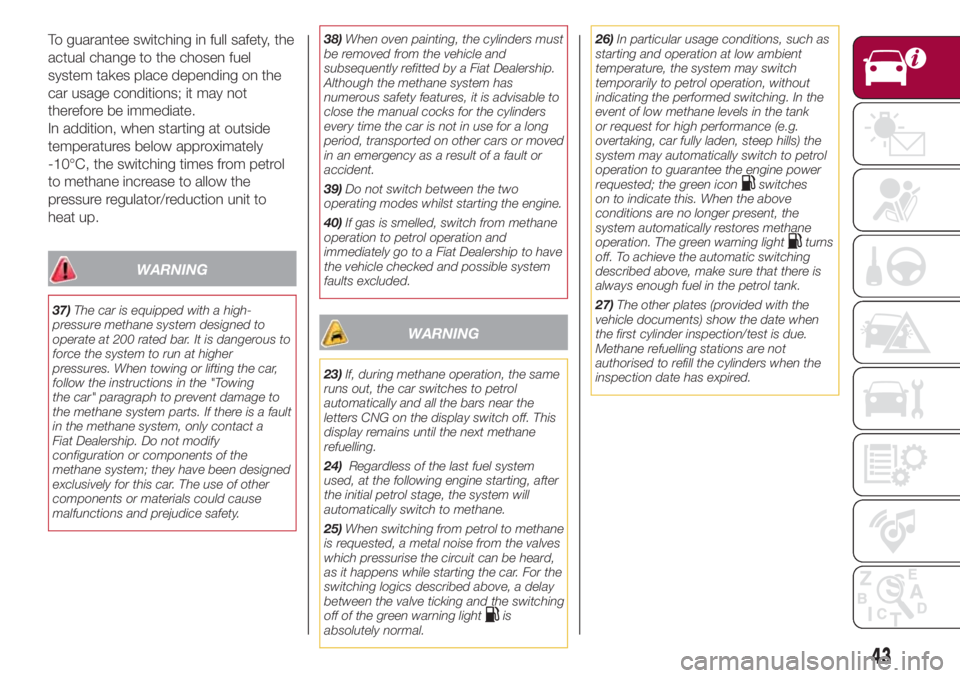
To guarantee switching in full safety, the
actual change to the chosen fuel
system takes place depending on the
car usage conditions; it may not
therefore be immediate.
In addition, when starting at outside
temperatures below approximately
-10°C, the switching times from petrol
to methane increase to allow the
pressure regulator/reduction unit to
heat up.
WARNING
37)The car is equipped with a high-
pressure methane system designed to
operate at 200 rated bar. It is dangerous to
force the system to run at higher
pressures. When towing or lifting the car,
follow the instructions in the "Towing
the car" paragraph to prevent damage to
the methane system parts. If there is a fault
in the methane system, only contact a
Fiat Dealership. Do not modify
configuration or components of the
methane system; they have been designed
exclusively for this car. The use of other
components or materials could cause
malfunctions and prejudice safety.38)When oven painting, the cylinders must
be removed from the vehicle and
subsequently refitted by a Fiat Dealership.
Although the methane system has
numerous safety features, it is advisable to
close the manual cocks for the cylinders
every time the car is not in use for a long
period, transported on other cars or moved
in an emergency as a result of a fault or
accident.
39)Do not switch between the two
operating modes whilst starting the engine.
40)If gas is smelled, switch from methane
operation to petrol operation and
immediately go to a Fiat Dealership to have
the vehicle checked and possible system
faults excluded.
WARNING
23)If, during methane operation, the same
runs out, the car switches to petrol
automatically and all the bars near the
letters CNG on the display switch off. This
display remains until the next methane
refuelling.
24)Regardless of the last fuel system
used, at the following engine starting, after
the initial petrol stage, the system will
automatically switch to methane.
25)When switching from petrol to methane
is requested, a metal noise from the valves
which pressurise the circuit can be heard,
as it happens while starting the car. For the
switching logics described above, a delay
between the valve ticking and the switching
off of the green warning light
is
absolutely normal.26)In particular usage conditions, such as
starting and operation at low ambient
temperature, the system may switch
temporarily to petrol operation, without
indicating the performed switching. In the
event of low methane levels in the tank
or request for high performance (e.g.
overtaking, car fully laden, steep hills) the
system may automatically switch to petrol
operation to guarantee the engine power
requested; the green icon
switches
on to indicate this. When the above
conditions are no longer present, the
system automatically restores methane
operation. The green warning light
turns
off. To achieve the automatic switching
described above, make sure that there is
always enough fuel in the petrol tank.
27)The other plates (provided with the
vehicle documents) show the date when
the first cylinder inspection/test is due.
Methane refuelling stations are not
authorised to refill the cylinders when the
inspection date has expired.
43
Page 58 of 268

Warning light What it means
REAR FOG LIGHT
The warning light switches on when the rear fog light is activated.
ABS FAILURE
The warning light switches on to indicate a system fault. In this case the braking system maintains its
efficiency unaltered but without the advantage of the ABS system.
Drive carefully and contact a Fiat Dealership as soon as possible.
HEATED REAR WINDOW
The warning light turns on when switching the heated rear window on.
HEATED WINDSCREEN
(for versions/markets, where provided)
The warning light turns on when the heated windscreen is turned on.
56
KNOWING THE INSTRUMENT PANEL
Page 75 of 268

ACTIVE SAFETY
SYSTEMS
The car has the following active safety
systems:
ABS (Anti-lock Braking System);
ESC (Electronic Stability Control)
system;
HH (Hill Holder) system;
ASR (AntiSlip Regulation) system;
DST (Dynamic Steering Torque
or steering corrector) system;
ERM (Electronic Rollover Mitigation)
system.
ABS (Anti-lock Braking
System)
43) 44) 45) 46) 47) 48) 49)
This system, which is an integral part of
the braking system, prevents one or
more wheels from locking and slipping
in all road surface conditions,
irrespective of the intensity of the
braking action, ensuring that the car
can be controlled even during
emergency braking and optimising
stopping distances.
The ABS also integrates the following
systems: EBD (Electronic Braking Force
Distribution), MSR (Motor
Schleppmoment Regelung) and HBA
(Hydraulic Brake Assist).IMPORTANT To obtain the maximum
efficiency of the braking system, a
bedding-in period of about 500 km is
needed: during this period it is better to
avoid sharp, repeated and prolonged
braking.
50) 51) 52)
System intervention
A slight pulsing of the brake pedal and
noise indicates the intervention of the
ABS: this is completely normal when
the system intervenes.
ESC (Electronic Stability
Control) SYSTEM
53) 54) 55) 56) 57) 58)
The ESC system corrects the car’s
understeer and oversteer, distributing
the brake force on the wheels
appropriately. The torque supplied by
the engine can also be reduced in order
to maintain control of the car.
System intervention
The intervention of the system is
indicated by the flashing of the
warning light on the instrument
panel, to inform the driver that the car is
in critical stability and grip conditions.Switching the system on
The ESC system switches on
automatically when the engine is
started and cannot be switched off.
GRAVITY CONTROL
(for versions/markets, where provided)
63)
It is an integral part of the ESC system
and is aimed at keeping the car at a
constant speed during a descent,
operating autonomously on the brakes
in various ways at the same time.
In this way, the “Gravity Control”
function assists the drive on steep
gradients in low-grip conditions and/or
on rough terrain.
For more information on system
operation, see the “Driving assistance
systems” paragraph in this chapter.
73
Page 76 of 268
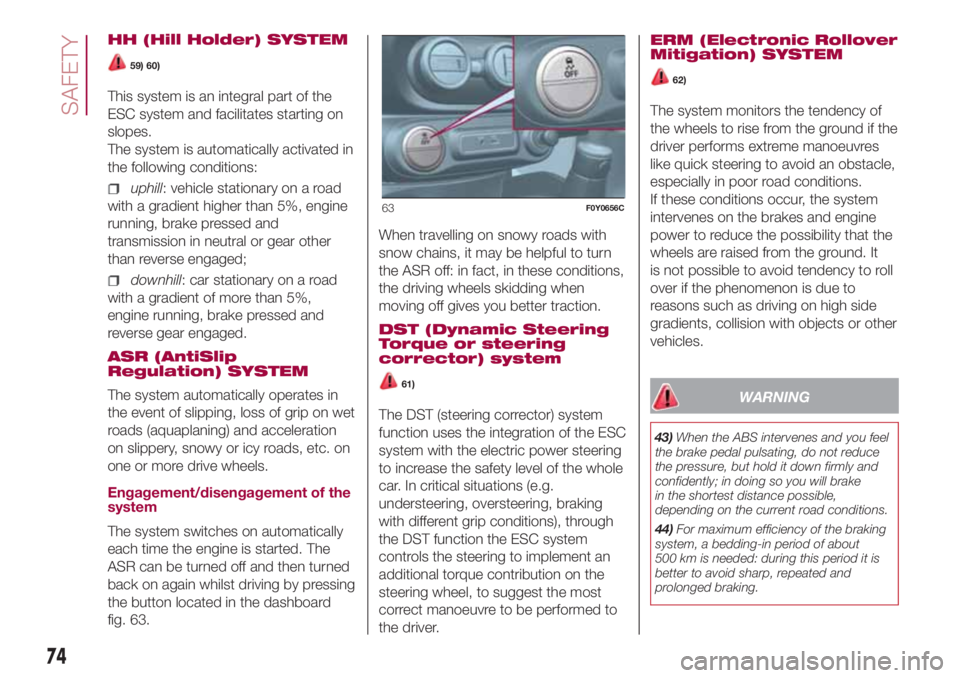
HH (Hill Holder) SYSTEM
59) 60)
This system is an integral part of the
ESC system and facilitates starting on
slopes.
The system is automatically activated in
the following conditions:
uphill: vehicle stationary on a road
with a gradient higher than 5%, engine
running, brake pressed and
transmission in neutral or gear other
than reverse engaged;
downhill: car stationary on a road
with a gradient of more than 5%,
engine running, brake pressed and
reverse gear engaged.
ASR (AntiSlip
Regulation) SYSTEM
The system automatically operates in
the event of slipping, loss of grip on wet
roads (aquaplaning) and acceleration
on slippery, snowy or icy roads, etc. on
one or more drive wheels.
Engagement/disengagement of the
system
The system switches on automatically
each time the engine is started. The
ASR can be turned off and then turned
back on again whilst driving by pressing
the button located in the dashboard
fig. 63.When travelling on snowy roads with
snow chains, it may be helpful to turn
the ASR off: in fact, in these conditions,
the driving wheels skidding when
moving off gives you better traction.
DST (Dynamic Steering
Torque or steering
corrector) system
61)
The DST (steering corrector) system
function uses the integration of the ESC
system with the electric power steering
to increase the safety level of the whole
car. In critical situations (e.g.
understeering, oversteering, braking
with different grip conditions), through
the DST function the ESC system
controls the steering to implement an
additional torque contribution on the
steering wheel, to suggest the most
correct manoeuvre to be performed to
the driver.ERM (Electronic Rollover
Mitigation) SYSTEM
62)
The system monitors the tendency of
the wheels to rise from the ground if the
driver performs extreme manoeuvres
like quick steering to avoid an obstacle,
especially in poor road conditions.
If these conditions occur, the system
intervenes on the brakes and engine
power to reduce the possibility that the
wheels are raised from the ground. It
is not possible to avoid tendency to roll
over if the phenomenon is due to
reasons such as driving on high side
gradients, collision with objects or other
vehicles.
WARNING
43)When the ABS intervenes and you feel
the brake pedal pulsating, do not reduce
the pressure, but hold it down firmly and
confidently; in doing so you will brake
in the shortest distance possible,
depending on the current road conditions.
44)For maximum efficiency of the braking
system, a bedding-in period of about
500 km is needed: during this period it is
better to avoid sharp, repeated and
prolonged braking.
63F0Y0656C
74
SAFETY